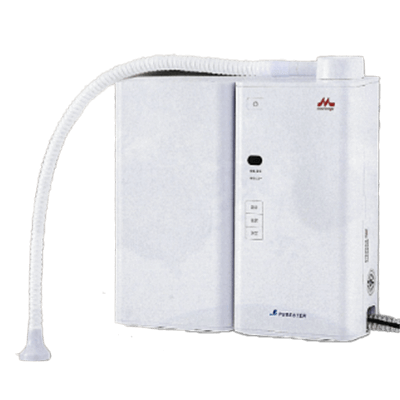What Is a Hypochlorous Acid Generator?

Hypochlorous acid is an aqueous solution containing hypochlorous acid as a solute, which can be obtained by electrolyzing brine or hydrochloric acid. It has been designated as a disinfectant food additive because it has shown effectiveness in sterilizing and removing a wide range of bacteria and viruses, and is not harmful to human health when used appropriately and in accordance with precautions for its use.
Hypochlorous acid as a food additive (disinfectant) is specified in terms of pH and effective chlorine concentration.
Hypochlorous acid designated as a food additive (disinfectant)
|
Electrolyzer |
pH |
Effective chlorine concentration(mg/kg) |
|
|
Slightly acidic hypochlorous acid |
One-chamber type |
5.0〜6.5 |
10 to 80 |
|
Weak acid hypochlorous acid |
Two-chamber/Three-chamber type |
2.8〜5.0 |
10 to 60 |
|
Strongly acidic hypochlorous acid |
Two-chamber/Three-chamber type |
2.7 or less |
20 to 60 |
Sodium hypochlorite is similar to hypochlorous acid. The difference between the two is that the form of hypochlorous acid molecules in aqueous solution differs, resulting in different sterilizing power. Sodium hypochlorite exists primarily in ionic form in aqueous solutions, whereas water hypochlorite exists primarily in molecular form in aqueous solutions.
The molecular form of hypochlorous acid is said to have higher disinfecting power than the ionic form, and at the same effective chlorine concentration, hypochlorous acid shows a higher disinfecting effect.
Sodium hypochlorite is generally used at relatively high concentrations of 200 ppm or higher to achieve sterilizing effects. This has been pointed out as a problem at food handling sites, where it can cause rough hands, and the smell of chlorine can adhere to food, affecting the taste, aroma, and texture of the food. On the other hand, hypochlorous acid has the advantage that it has less impact on food and people because it has a sterilizing effect at a lower concentration.
A hypochlorous acid generator is a device that can generate hypochlorous acid instantly, and by using a hypochlorous acid generator, you can perform sanitation control such as sterilization and deodorization safely and inexpensively without spending time and effort.
Hypochlorous acid generators come in various sizes, so you can work efficiently by selecting the right size for your purpose of use.
Uses of Hypochlorous Acid Generators
The following describes the uses of hypochlorous acid generators.
With a hypochlorous acid generator, safe hypochlorous acid can be used immediately like tap water, without the need for dilution or other work.
These hypochlorous acid generators are used in various fields such as medical and welfare facilities, educational facilities, agriculture, fishery industry, restaurants, and food processing facilities because they enable efficient hygiene control.
For example, in food processing facilities and restaurants, it is used to sterilize cooking utensils, facilities, and various food materials. In medical, welfare, and educational facilities, it is used to sterilize inside facilities and to clean and sterilize utensils and clothing.
Hypochlorous acid is a sterilizing water designated as a food additive. Recently, however, products outside the scope of food additive regulations have been distributed as hypochlorous acid generators, and care should be taken to use products within the scope of food additive regulations (sterilizing agents) when using them to sterilize foodstuffs.
Principle of Hypochlorous Acid Generators
Next, the principle of hypochlorous acid generator is explained.
Hypochlorous acid is obtained by electrolyzing brine or dilute hydrochloric acid. Strongly acidic hypochlorous acid and weakly acidic hypochlorous acid are produced by electrolyzing brine water in an electrolysis tank with an anode and a cathode separated by a membrane to produce hypochlorous acid from the anode
On the other hand, slightly acidic hypochlorous acid is produced by electrolyzing dilute hydrochloric acid or a mixture of dilute hydrochloric acid and salt in a non-diaphragm electrolysis tank.
Hypochlorous Acid Generator Designated as a Food Additive (Disinfectant)
Hypochlorous acid is used as a disinfecting food additive, and the standard criteria and usage methods for pH, effective chlorine concentration, ingredients, and generator are specified.
1. Component Standards and Equipment for Hypochlorous Acid Designated as a Food Additive
- Slightly acidic hypochlorous acid (pH 5.0-6.5, effective chlorine concentration 10-80ppm)
Generator: One-chamber electrolyzer
Electrolyte: Hydrochloric acid water or hydrochloric acid + sodium chloride solution - Weak acid hypochlorous acid (pH 2.8-5.0, effective chlorine concentration 10-60ppm)
Generator: Two-chamber electrolyzer / Three-chamber electrolyzer
Electrolyte: Sodium chloride solution - Strongly acidic hypochlorous acid (pH 2.7 or less, effective chlorine concentration 20-60ppm)
Generator: 2-chamber electrolyzer/ 3-chamber electrolyzer
Electrolyte: Sodium chloride solution
2. Usage Standards
- Before use, confirm that the pH and effective chlorine concentration of the hypochlorous acid are within the specified limits.
- Before use, remove contaminants with tap water, wash with hypochlorous acid, and rinse with tap water.
Hypochlorous Acid Generator for Coronavirus Infection Control
Hypochlorous acid has been proven effective against a new type of coronavirus (SARS-CoV-2) by the National Institute of Technology and Evaluation (NITE). However, the following conditions apply depending on the intended use.
- When used for wiping
An effective chlorine concentration of 80 ppm or higher should be used. - When used by pouring from a generator
An effective chlorine concentration of 35 ppm or higher should be used.
The following are points to keep in mind when using the product
- If there is visible dirt on the water, remove it beforehand.
- Use a sufficient amount of hypochlorous acid.
When using by pouring, pour the liquid over the object to be disinfected for at least 20 seconds.
Note that hypochlorous acid has not been verified to be effective when used in small quantities. It should also be noted that the verification by NITE was conducted assuming the sterilization of articles, and the effectiveness of the water for sterilization of hands and fingers, as well as the specific method of use, are not subject to evaluation.